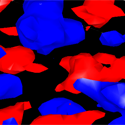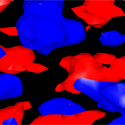Bacteria, live in 3D
Like cyclists, birds and fish travel more efficiently as a team. Experiments have also shown that bacterial cells move in collective swarms, but since viscous forces are more pronounced for these micron-sized swimmers, it wasn’t clear if this behavior actually offered a benefit in energy. Now, by making a quasi-3D velocity map of a liquid droplet containing motile Escherichia coli (E. coli), a team of scientists in Japan has concluded that bacteria swimming in a group are able to move roughly three times faster than they would on their own. The results are reported in Physical Review Letters.
The small droplets of cell culture that Takuji Ishikawa and his colleagues at Tohoku University studied contained more than a million bacteria. Since tracking each cell individually would have been too slow to obtain a picture of the bacteria’s collective motion, the team instead used a camera and microscope to monitor the flow of fluorescent tracers in the surrounding liquid. The technique allowed them to take either short movies of the fluid flow in a 2D cut through the droplet, or semi-3D maps by piecing together 2D snapshots taken in quick succession.
Since the resolution of Ishikawa et al.’s imaging setup is significantly larger than the cells themselves, what the team actually measures is the average thrust force each cell needs to exert to stay in collective motion. By comparing these results to calculations of how a lone bacterium would swim, they show the cells expend little extra effort to swim significantly faster. – Jessica Thomas





